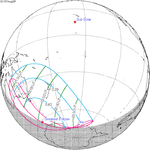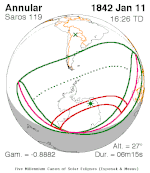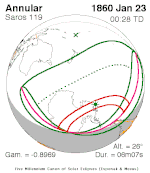A partial solar eclipse occurred at the Moon's ascending node of orbit on Thursday, March 28, 1968, with a magnitude of 0.899. A solar eclipse occurs when the Moon passes between Earth and the Sun, thereby totally or partly obscuring the image of the Sun for a viewer on Earth. A partial solar eclipse occurs in the polar regions of the Earth when the center of the Moon's shadow misses the Earth.
| Solar eclipse of March 28, 1968 | |
|---|---|
| Type of eclipse | |
| Nature | Partial |
| Gamma | −1.037 |
| Magnitude | 0.899 |
| Maximum eclipse | |
| Coordinates | 61°00′S 79°48′W / 61°S 79.8°W |
| Times (UTC) | |
| Greatest eclipse | 23:00:30 |
| References | |
| Saros | 119 (63 of 71) |
| Catalog # (SE5000) | 9438 |
Related eclipses
Eclipses in 1968
- A partial solar eclipse on March 28, 1968.
- A total lunar eclipse on April 13, 1968.
- A total solar eclipse on September 22, 1968.
- A total lunar eclipse on October 6, 1968.
Metonic
- Preceded by: Solar eclipse of June 10, 1964
- Followed by: Solar eclipse of January 16, 1972
Tzolkinex
- Preceded by: Solar eclipse of February 15, 1961
- Followed by: Solar eclipse of May 11, 1975
Half-Saros
- Preceded by: Lunar eclipse of March 24, 1959
- Followed by: Lunar eclipse of April 4, 1977
Tritos
- Preceded by: Solar eclipse of April 30, 1957
- Followed by: Solar eclipse of February 26, 1979
Solar Saros 119
- Preceded by: Solar eclipse of March 18, 1950
- Followed by: Solar eclipse of April 9, 1986
Inex
- Preceded by: Solar eclipse of April 19, 1939
- Followed by: Solar eclipse of March 9, 1997
Triad
- Preceded by: Solar eclipse of May 27, 1881
- Followed by: Solar eclipse of January 27, 2055
Solar eclipses of 1968–1971
This eclipse is a member of a semester series. An eclipse in a semester series of solar eclipses repeats approximately every 177 days and 4 hours (a semester) at alternating nodes of the Moon's orbit.[1]
The partial solar eclipse on July 22, 1971 occurs in the next lunar year eclipse set.
| Solar eclipse series sets from 1968 to 1971 | ||||||
|---|---|---|---|---|---|---|
| Ascending node | Descending node | |||||
| Saros | Map | Gamma | Saros | Map | Gamma | |
| 119 | March 28, 2968 Partial | −1.037 | 124 | September 22, 1968 Total | 0.9451 | |
| 129 | March 18, 1969 Annular | −0.2704 | 134 | September 11, 1969 Annular | 0.2201 | |
139 Totality in Williamston, NC USA | March 7, 1970 Total | 0.4473 | 144 | August 31, 1970 Annular | −0.5364 | |
| 149 | February 25, 1971 Partial | 1.1188 | 154 | August 20, 1971 Partial | −1.2659 | |
Saros 119
This eclipse is a part of Saros series 119, repeating every 18 years, 11 days, and containing 71 events. The series started with a partial solar eclipse on May 15, 850 AD. It contains total eclipses on August 9, 994 AD and August 20, 1012; a hybrid eclipse on August 31, 1030; and annular eclipses from September 10, 1048 through March 18, 1950. The series ends at member 71 as a partial eclipse on June 24, 2112. Its eclipses are tabulated in three columns; every third eclipse in the same column is one exeligmos apart, so they all cast shadows over approximately the same parts of the Earth.
The longest duration of totality was produced by member 10 at 32 seconds on August 20, 1012, and the longest duration of annularity was produced by member 44 at 7 minutes, 37 seconds on September 1, 1625. All eclipses in this series occur at the Moon’s ascending node of orbit.[2]
| Series members 54–71 occur between 1801 and 2112: | ||
|---|---|---|
| 54 | 55 | 56 |
 December 21, 1805 |  January 1, 1824 |  January 11, 1842 |
| 57 | 58 | 59 |
 January 23, 1860 |  February 2, 1878 |  February 13, 1896 |
| 60 | 61 | 62 |
 February 25, 1914 |  March 7, 1932 |  March 18, 1950 |
| 63 | 64 | 65 |
 March 28, 1968 |  April 9, 1986 |  April 19, 2004 |
| 66 | 67 | 68 |
 April 30, 2022 |  May 11, 2040 |  May 22, 2058 |
| 69 | 70 | 71 |
 June 1, 2076 |  June 13, 2094 |  June 24, 2112 |
Metonic series
The metonic series repeats eclipses every 19 years (6939.69 days), lasting about 5 cycles. Eclipses occur in nearly the same calendar date. In addition, the octon subseries repeats 1/5 of that or every 3.8 years (1387.94 days). All eclipses in this table occur at the Moon's ascending node.
| 21 eclipse events, progressing from south to north between June 10, 1964, and August 21, 2036 | ||||
|---|---|---|---|---|
| June 10–11 | March 27–29 | January 15–16 | November 3 | August 21–22 |
| 117 | 119 | 121 | 123 | 125 |
 June 10, 1964 |  March 28, 1968 |  January 16, 1972 |  November 3, 1975 |  August 22, 1979 |
| 127 | 129 | 131 | 133 | 135 |
 June 11, 1983 |  March 29, 1987 |  January 15, 1991 |  November 3, 1994 |  August 22, 1998 |
| 137 | 139 | 141 | 143 | 145 |
 June 10, 2002 |  March 29, 2006 |  January 15, 2010 |  November 3, 2013 |  August 21, 2017 |
| 147 | 149 | 151 | 153 | 155 |
 June 10, 2021 |  March 29, 2025 |  January 14, 2029 |  November 3, 2032 |  August 21, 2036 |
References
External links
- Earth visibility chart and eclipse statistics Eclipse Predictions by Fred Espenak, NASA/GSFC

